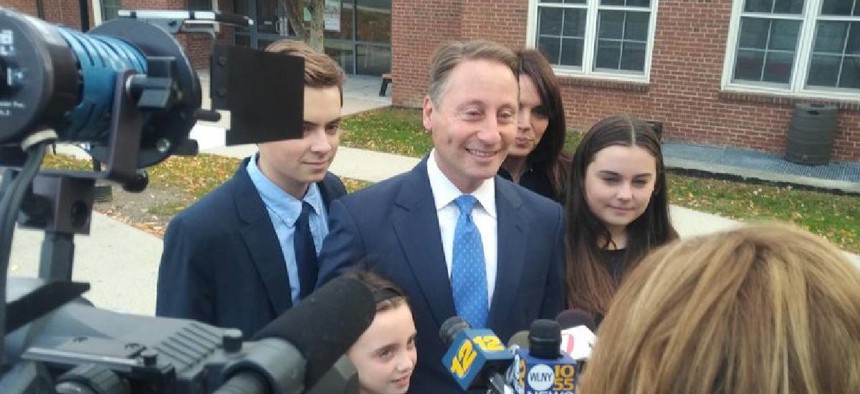Now that last Tuesday’s election returns have been tabulated, what are the enduring electoral lessons? Let’s explore that question by analyzing the four major contests in New York.
First, in New York City, the fulcrum point in the electorate now lies with Latino and Asian voters. Shane Goldmacher wrote a splendid piece in The New York Times exquisitely capturing the narrative of the mayoral campaign, but I believe that Goldmacher missed the arithmetic at the core of New York City’s electoral equation.
Goldmacher accepted the central assumption of de Blasio’s political team: If they won three-quarters of the black vote, the mayor would win because any opponent would face the nearly impossible mission of garnering 61 percent from the rest of the electorate. But that calculation misses the fact that no one or even two voting blocs dominate New York City politics.
Today, there are three relatively equal voting blocs in New York City: blacks (casting a 26-28 percent share), outer borough Jewish and white Catholic voters (at 27-30 percent), with Latino and Asian voters (at 24-27 percent of the city’s total vote).
New class voters (the highly educated, professional, mostly white voters, including LGBT, who dominate in Manhattan and the gentrifying neighborhoods of Brooklyn and Queens) are the remaining bloc, with just under a fifth of the city’s total vote (a 16-19 percent share).
Latino and Asian voters do not march together, but they usually wind up at the same destination in terms of candidate support. Moreover, in polling on issues like criminal justice, education and housing, Latino and Asian voters tend to fall between the views of black and white voters.
My alternative to the de Blasio team’s postulate is that the mayor was a prohibitive favorite to win precisely because no single candidate had the wingspan to win simultaneous support from white Catholic, Jewish, new class, Latino and Asian voters. If de Blasio got 80 percent of black voters, but an opponent got 70 percent of white Catholic and Jewish voters, that would not have been a prohibitive advantage. Therefore, the lesson to be learned is that Latino and Asian voters (who will grow to a full third of the electorate by 2025) have become the city’s ultimate swing voters.
Second, Democrat Laura Curran’s victory over Republican Jack Martins in the Nassau County executive’s race may have predictive value for future contests.
Independents in Nassau County determine elections, as registration between the parties is relatively even (397,859 Democrats to 336,208 Republicans) while independents number 239,342 (just shy of a quarter of Nassau County’s 1,025,598 registered voters).
In the past, when Nassau County’s independent voters drive a change in the county executive’s office, it has proven a harbinger of voting patterns for independents statewide. In 2001, when Democrat Tom Suozzi was first elected county executive, that foreshadowed independents breaking against Republicans, which played out in the state’s 2006 and 2008 elections. Then in 2009, after Republican Ed Mangano was elected, New York’s independent voters tended to turn against Democrats in 2010 and 2014. The question going forward will be whether Curran’s victory will once again presage independents shifting against the Republicans across New York in the 2018 and 2020 elections.
Third, in Westchester County, Democrat George Latimer’s victory over incumbent Republican County Executive Rob Astorino puts a spotlight on three lessons. One, unlike New York’s governors, who have a rich tradition of third and fourth terms, county executives and mayors often face a third-term jinx. That took Astorino down.
Two, public foibles usually trump private blemishes with voters. Pundits thought Astorino had beaten down Latimer’s prospects by exposing the Democrat’s family issues, but Latimer proved a doggedly resilient campaigner. Then Astorino tripped over testimony from the Norman Seabrook trial, which asserted that Astorino had accepted a Rolex watch largely paid for by embattled real estate developer Jona Rechnitz. Astorino was never able to persuasively explain that controversy to voters. Furthermore, the registration advantage has swung so sharply to the Democrats in Westchester County (302,376 Democrats to 140,118 Republicans with 147,483 independents), that if a Democratic candidate can unify his party, Republican candidates, even an incumbent like Astorino, are behind the eight ball.
Fourth, in the Syracuse mayoral election, independent candidate Ben Walsh won. The key to the outcome was going to be whether Democrat Juanita Perez Williams could connect with black voters as well as to conservative white Democrats or whether Walsh would be able to add Republican voters to his independent base. Early polls showed the Republican nominee Laura Lavine with 30 percent of Republican support and 15 percent of Republicans leaning toward Joe Nicoletti.
When the votes were counted, however, Walsh won 54 to 38 percent over Perez Williams because the support for Lavine (2 percent) and Nicoletti (1 percent) melted away, allowing Walsh to aggregate Republican and independent voters.
Of the Democrats 3.4 million statewide registration advantage, more than 2.9 million comes from New York City. Outside New York City, the Democrats’ registration advantage is only 480,556 voters, with 1,738,892 independent voters. The ineluctable lesson for analyzing elections outside the city is that independent voters drive the electoral engine.
When you boil all this down, the most enduring lessons charting the future course of New York’s politics become where will Latino and Asian voters from New York City and independent voters outside New York City land. For as they go politically, so goes the Empire State.
Bruce N. Gyory is a political and strategic consultant at Manatt, Phelps & Phillips LLP and an adjunct professor of political science at the University at Albany.


